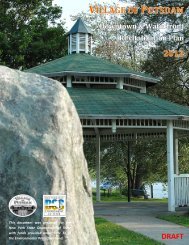Source - Vi.potsdam.ny.us - Potsdam
Source - Vi.potsdam.ny.us - Potsdam
Source - Vi.potsdam.ny.us - Potsdam
You also want an ePaper? Increase the reach of your titles
YUMPU automatically turns print PDFs into web optimized ePapers that Google loves.
7/1/2005 AC 150/5325-4B<br />
CHAPTER 2. RUNWAY LENGTHS FOR SMALL AIRPLANES WITH MAXIMUM CERTIFICATED<br />
TAKEOFF WEIGHT OF 12,500 POUNDS (5,670 KG) OR LESS<br />
201. DESIGN GUIDELINES. The design procedure for small airplanes requires the following information: the<br />
critical design airplanes under evaluation, approach speed in knots (1.3 x stall speed), number of passenger seats,<br />
airport elevation above mean sea level, and the mean daily maximum temperature of the hottest month at the airport.<br />
Once obtained, apply the guidance from the appropriate paragraph below to obtain the recommended runway length.<br />
For this airplane weight category, no further adj<strong>us</strong>tment to the obtained length from the figures 2.1 or 2.2 is<br />
necessary. For example, there is no operational requirement to take into account the effect of effective runway<br />
gradient for takeoff or landing performance.<br />
202. DESIGN APPROACH. For purposes of design, this AC provides a design concept for airports that serve<br />
only airplanes with a maximum certificated takeoff weight of 12,500 pounds (5,670 kg) or less. The design concept<br />
starts by grouping all small airplanes, that is, the critical design airplanes, according to approach speed. The highest<br />
approach speed group is divided on the basis of passenger seats, namely, “airplanes having fewer than 10 passenger<br />
seats” as compared to “airplanes having 10 or more passenger seats.” The less than 10 passenger seats category is<br />
further based on two percentages of fleet, namely, “95 percent of the fleet” or “100 percent of the fleet” categories,<br />
as explained in paragraph 205. For these airplanes, figures 2-1 and 2-2 show only a single curve that takes into<br />
account the most demanding operations to obtain the recommended runway length. Although both figures pertain<br />
mainly to small propeller driven airplanes, figure 2-2 does include small turbo-powered airplanes. Airport designers<br />
can, instead of applying the small airplane design concept, determine the recommended runway length from airplane<br />
flight manuals for the airplanes to be accommodated by the airport in lieu of the runway length curves depicted in<br />
figures 2-1 or 2-2. For example, owners of multi-engine airplanes may require that their pilots <strong>us</strong>e the airplane’s<br />
accelerate-stop distance in determining the length of runway available for takeoff.<br />
203. SMALL AIRPLANES WITH APPROACH SPEEDS OF LESS THAN 30 KNOTS. Airplanes with<br />
approach speeds of less than 30 knots are considered to be short takeoff and landing or ultra light airplanes. Their<br />
recommended runway length is 300 feet (92 meters) at mean sea level. Runways located above mean sea level<br />
should be increased at the rate of 0.03 x airport elevation above mean sea level to obtain the recommended runway<br />
length at that elevation.<br />
204. SMALL AIRPLANES WITH APPROACH SPEEDS OF 30 KNOTS OR MORE BUT LESS THAN<br />
50 KNOTS. The recommended runway length is 800 feet (244 meters) at mean sea level. Runway lengths above<br />
mean sea level should be increased at the rate of 0.08 x airport elevation above mean sea level to obtain the<br />
recommended runway length at that elevation.<br />
205. SMALL AIRPLANES WITH APPROACH SPEEDS OF 50 KNOTS OR MORE WITH MAXIMUM<br />
CERTIFICATED TAKEOFF WEIGHT OF 12,500 POUNDS (5,670 KG) OR LESS. Figures 2-1 and 2-2<br />
provide the recommended runway lengths based on the seating capacity and the mean daily maximum temperature<br />
of the hottest month of the year at the airport. The fleet <strong>us</strong>ed in the development of the figures consisted of small<br />
airplanes certificated in the United States. Figure 2-1 categorizes small airplanes with less than 10 passenger seats<br />
(excludes pilot and co-pilot) into two family groupings according to “percent of fleet,” namely, 95 and 100 percent<br />
of the fleet. Figure 2-2 categorizes all small airplanes with 10 or more passenger seats into one family grouping.<br />
Figure 2-2 further alerts the airport designer that for airport elevations above 3,000 feet (914 m), that the airport<br />
designer m<strong>us</strong>t <strong>us</strong>e the 100 percent of fleet chart of figure 2-1 instead of <strong>us</strong>ing figure 2-2. As shown, both figures<br />
provide examples that start with the horizontal temperature axis then, proceed vertically to the applicable airport<br />
elevation curve, followed by proceeding horizontally to the vertical axis to read the recommended runway length.<br />
a. Selecting Percentage of Fleet for Figure 2-1. The differences between the two percentage<br />
categories are based on the airport’s location and the amount of existing or planned aviation activities. The airport<br />
designer should make the selection based on the following criteria.<br />
(1) 95 Percent of Fleet. This category applies to airports that are primarily intended to serve<br />
medium size population communities with a diversity of <strong>us</strong>age and a greater potential for increased aviation<br />
activities. Also included in this category are those airports that are primarily intended to serve low-activity<br />
5



